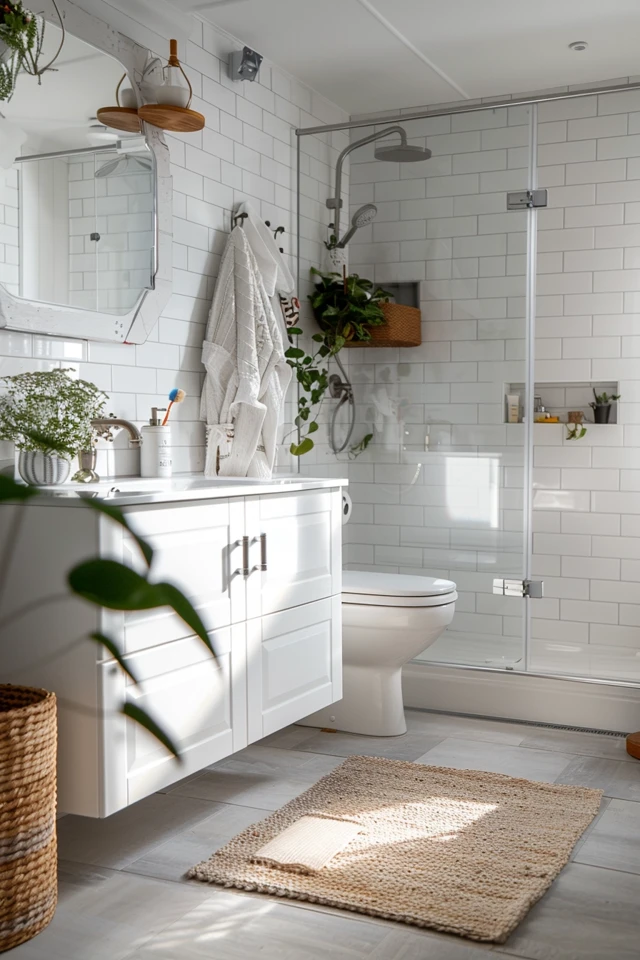Hello, I’m excited to share with you some valuable information about expanding a half bath into a full bathroom. If you are considering bathroom remodeling or looking for small space conversion ideas, this article will provide you with essential insights. Converting a half bath into a full bath requires careful planning and consideration of various factors such as maximizing space, plumbing considerations, and increasing property value.
Before we dive into the details, let’s clarify the difference between a half bath and a full bath. A half bath, also known as a powder room, consists of only a sink and a toilet. In contrast, a full bath includes all four features – sink, toilet, tub, and shower. If you’re looking to enhance your bathroom experience, expanding your half bath into a full bathroom can be a fantastic home renovation idea.
Key Takeaways:
- Converting a half bath into a full bath requires careful planning and consideration.
- A half bath consists of a sink and a toilet, while a full bath includes a sink, toilet, tub, and shower.
- Maximizing space, plumbing considerations, and increasing property value are vital factors to consider.
- Consult with professionals such as plumbers and electricians to ensure proper installation and compliance with building codes.
- A half-bath to full-bath conversion can significantly enhance the value and functionality of your property.

Key Steps for Converting a Half Bath Into a Full
Converting a half bath into a full bath involves several key steps. To ensure a successful bathroom remodeling project and small space conversion, it’s essential to follow these expansion techniques and consider plumbing considerations:
- Assess the Available Space: The first step in converting a half bath into a full bathroom is to assess the available space. Determine if any modifications or expansions are necessary to accommodate the additional fixtures. Consider maximizing space by optimizing the layout and utilizing clever storage solutions.
- Check Plumbing and Electrical Systems: Before proceeding with the expansion, it’s crucial to check the existing plumbing and electrical systems. Ensure that they can accommodate the additional fixtures, such as showers, tubs, and sinks. Plumbing considerations may include installing vented 2-inch drain lines and hot and cold water supply pipes. Consulting a professional plumber is recommended to ensure proper installations.
- Obtain Necessary Permits: Before commencing the bathroom remodeling project, it’s important to obtain all necessary permits from the local government. Compliance with safety and building codes is essential to ensure a smooth and legal renovation process.
- Demolition and Structural Changes: Once the necessary permits are in place, the next step is to proceed with demolition and structural changes. This may involve removing existing walls, rerouting plumbing and electrical lines, and creating space for the new fixtures.
- Plumbing and Electrical Work: After the structural changes are complete, the plumbing and electrical work can commence. This includes installing new pipes, drains, and electrical lines to accommodate the full bathroom fixtures.
- Install New Fixtures: With the plumbing and electrical work in place, it’s time to install the new fixtures. This may include showers, tubs, sinks, toilets, faucets, and lighting fixtures. Choose fixtures that suit the design and functionality of your new full bathroom.
- Add Finishing Touches: Once the fixtures are installed, add the finishing touches to complete the bathroom conversion. This may involve applying paint, installing tile or flooring, and adding decorative elements to enhance the overall aesthetic appeal of the space.
Converting a half bath into a full bathroom requires careful planning, attention to detail, and consideration of plumbing considerations. By following these key steps, you can successfully convert a small bathroom into a functional and beautiful full bath, maximizing the potential of your space and adding value to your home.

Considerations and Cost
When converting a half bath into a full bath, there are several important considerations to keep in mind. Firstly, you’ll need to assess the plumbing requirements for the type of full bath you desire. Most bathrooms will require a vented 2-inch drain line, hot and cold water supply pipes, and additional electrical outlets.
To ensure the plumbing and electrical work is done correctly, it’s essential to consult with a qualified plumber and electrician. They will be able to guide you through the process and ensure that all necessary installations and connections are made.
In addition to the technical considerations, it’s also important to obtain any required permits from the local government. This is necessary to comply with safety and building code requirements, ensuring that the renovation is done according to regulations.
While the cost of converting a half bath into a full bath can vary depending on the scope of the renovation, the average range is between $10,000 and $30,000. However, it’s important to consider the potential increase in property value that this renovation can bring. By adding a full bath, you are maximizing the space and functionality of your home, which can significantly enhance its appeal to potential buyers.


